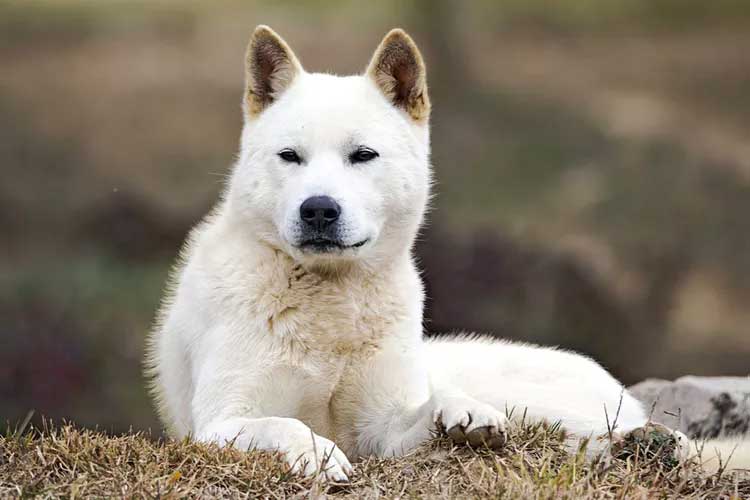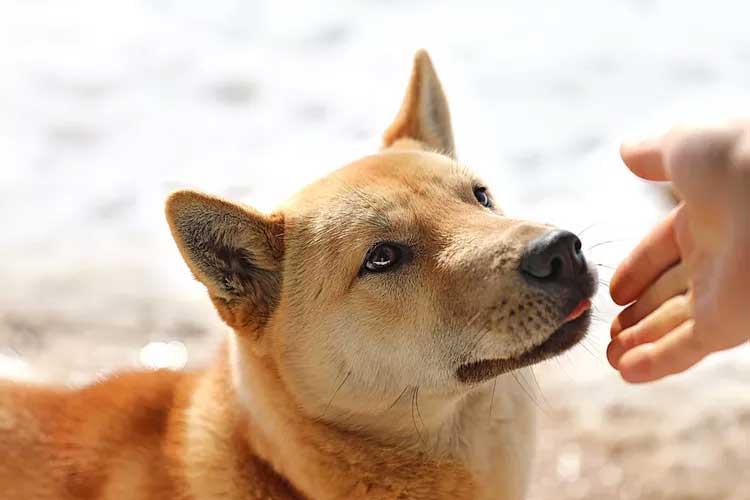The Jindo is a loyal, alert dog that originated in South Korea. This breed enjoys a lot of physical activity (hiking is his favorite!) with his family.

Jindo Overview
| OFFICIAL NAME | Jindo |
| COMMON NAME | Jindo |
| PET HEIGHT | 18 to 22 inches |
| PET WEIGHT | 30 to 50 pounds |
| LIFESPAN | 12 to 15 years |
| GOOD WITH | children, dogs, families |
| TEMPERAMENT | anxious, gentle, playful |
| INTELLIGENCE | high |
| SHEDDING AMOUNT | seasonal |
| EXERCISE NEEDS | medium |
| ENERGY LEVEL | active |
| VOCAL LEVEL | when necessary |
| DROOL AMOUNT | low |
| BREED GROUP | none |
| BREED SIZE | medium (26-60 lbs.) |
| COAT LENGTH | medium |
| COLORS | fawn, gray, white |
| PATTERNS | black and tan, brindle |
| OTHER TRAITS | apartment-friendly, good hiking companion, high prey drive, strong loyalty tendencies |
The Korean Jindo is a medium-sized dog who is incredibly loyal to his owner, highly intelligent, and thrives with an active lifestyle. But while Korean Jindos (also known simply as Jindos) are a popular pet in South Korea, there is also a history of them being bred for consumption. They are relatively unknown in the United States, but have grown more prominent as rescue organizations work to save Jindos from the dog meat trade and high-kill shelters in South Korea.
Patti Kim, president and co-founder of Jindo Love Rescue, says she is drawn to rescuing Jindos and placing them in loving homes in the U.S. because of the dire nature of how they are treated.
"People ask why I don't just adopt locally, and my answer is that every dog needs a home," Kim says. "But the dogs that are destined for the dog meat trade literally have no hope. My calling is for the dogs in Korea because of how they're killed."
Gina Boehler, executive director of Korean K9 Rescue, says her organization primarily rescues from high-kill shelters or those who are abandoned on the street. She recommends that new Jindo owners give their new family member a lot of space and time to decompress after coming from such an environment. Once they are settled with a structured schedule, the Jindo makes a loving and devoted companion.
"If we respect the Jindo coming into our home and give that dog time to acclimate, they are going to be the best friend that you ever had," Boehler says. "We just need to give them that chance in the beginning and look at it from their point of view."
Appearance
With perked up ears and a sickle-shaped tail, the Jindo's agile body often mirrors his equally alert personality. His almond-shaped eyes are dark brown, and they give every Jindo the perfect "puppy dog expression" to deploy when he's ready for another walk. He stands between 18–22 inches in height, making him an ideal medium-sized companion for a family that loves hikes and adventures. The Jindo weighs between 30–50 pounds, but he is light on his feet and carries himself with poise.
The Jindo's thick double coat comes in white, gray, fawn, black and tan, and brindle. Even though he can shed significantly each season, the Jindo breed is also known for keeping themselves quite clean (in fact, they are very easy to potty train for this reason). The Jindo appears perpetually ready to go and can often be spotted with a wagging tail when he is comfortable or near his owner.
"When they're outside, they're very active," Boehler says. "Their tail starts to wag, their eyes get bright. They love being outside hiking with their owners or taking lots of walks."
Because of his foxy face and perky ears, you might first mistake a Jindo for a Shiba Inu. But if you know what to look for, it's easy to tell apart a Jindo vs. Shiba Inu. Some giveaways: A Shiba is smaller (only reaching about 23 pounds) and has cute chubby cheeks the Jindo lacks.
Temperament
The Jindo is renowned for his devotion and is exceptionally loyal to his people. He has a generally calm temperament but also can be suspicious of strangers and have a strong prey drive. Especially with a rescued Jindo, it is important that owners are willing to dedicate a significant amount of time to earning his trust and socializing him with other pets and people.While Jindos can be a good fit for first-time owners, Boehler recommends doing a lot of research about the breed before adopting. Many Jindos who are available for adoption in the U.S. have been rescued from slaughterhouses or high-kill shelters, and they can be under-socialized as a result of their upbringing. While volunteers at Korean K9 Rescue work with the Jindos to build the dogs' positive associations with humans, they can be more reserved until that trust is fully earned.
"The trauma, timidness, fearfulness can be passed down from the mother to their litters. It can be challenging for certain people to adopt a dog like that," Boehler says. "We're looking for somebody who's willing to put effort in. They may not have the most confident, outgoing dog, but they will have a family member that is loved."

But earning their Jindo's trust is well worth the effort. He is incredibly smart, enjoys learning new skills, and makes a very polite member of the household. Once settled in, he will be happy to join any family member for a long walk or a DIY agility course in the backyard.
"They're super loyal, not only to one human, but to family members," Boehler says. "They are people pleasers; they want to be by your side."
Living Needs
Most Jindos would be happiest in an active household where they have a family that wants to include them in all parts of the day. His ideal schedule? Most Jindos would enjoy a 30-minute morning walk (or jog!), a visit to an enclosed dog park, then settling in at home with their human while pondering the latest dog puzzle. Kim says that the Jindo is a breed that needs mental and physical stimulation throughout the day—he is certainly not a couch potato pup."For Jindos, we look for active people who go on hikes or already do a lot outdoors," Kim says. "People who will take the dog to the beach or outdoor restaurants so they have all that exposure. If you're working from home and you walk them two or three times a day around the block, and pretty much just stay home, then the Jindo is not the right dog for you."
As long as they are well-socialized, Jindos love playing with other dogs or entertaining kids. Kim says that Jindos can thrive in households with other dogs (and even cats if they are introduced properly, though the Jindo's high prey drive might make them want to chase kitties).

The Jindo should not be left alone for prolonged periods of time—especially not in the backyard, where he might decide to go on an adventure without you. As an intelligent breed, the Jindo can be known as a bit of an escape artist, even with a fenced-in yard. Especially when brought to a new environment, he can be drawn to leave home for a number of reasons, such as spotting a squirrel to chase, feeling like he is not in his true home, or simple curiosity. Owners need to be diligent about watching their Jindo in the backyard, building a strong relationship, and keeping him on-leash when necessary. Korean K9 Rescue uses Fi GPS collars that allow owners to find their dog's location, if needed.
"It takes 3–12 months for these dogs to really feel at home," Boehler says. "We reduce the Jindo's flight risk by using GPS collars but also by using training as a method to build the owner's relationship with the dog and help it become less of a flight risk."
Care
The Jindo needs regular exercise and socialization, so he should share a home with an active family. It is vital to the Jindo's happiness that he is well-socialized, either as a puppy or during training. If your Jindo is not exposed to other dogs and people in his early days, he can be prone to suspicious behavior.Owners will need to be patient with their Jindo, but this highly intelligent breed learns quickly once they build a solid relationship with their human. Use positive reinforcement training and relationship-based training to ensure your Jindo is confident and understands what is being asked of him.
Like other double-coated dogs, the Jindo will blow his coat twice each year. Jindos who are living in a new environment may experience more shedding until their bodies adjust to the new climate, Boehler says. To keep the Jindo's double coat looking beautiful, she recommends brushing him weekly with a slicker or pin brush.
Health
The Jindo is a healthy breed that typically lives between 12–15 years. The Korean Jindo Association of America attributes the Jindo's good health to its natural development in South Korea for many centuries.The Jindo is relatively new to the United States, so the breed's long-term health testing is still being explored. The American Kennel Club (AKC) says that some Jindos in the U.S. have shown signs of hypothyroidism, which impacts the thyroid glands. They can also experience dog allergies, which can happen when a dog is exposed to a new environment and their immune system reacts to the change.
Owners should also be aware of isolated instances where Jindos have experienced cataracts and hip dysplasia, so owners may want to keep an eye out for any symptoms of joint or eye problems. The Korean Jindo Association of America warns that some rescue dogs can be at higher risk for health problems, but overall, owners can expect their Jindo to live an active, robust life.
History
The Korean Jindo originates from Jindo Island, the third largest island in South Korea. Despite the namesake, how the Jindo first arrived on the island is largely a mystery. The South Korean Cultural Heritage Administration speculates the beloved dogs were introduced to South Korea around 220 AD when a trade ship from China was wrecked along the coast. Others believe the dogs arrived later, during the Mongol invasions of Korea. No matter the origin story, the Jindo breed has been a part of the island for centuries and is a cherished part of its identity.
In 1962, the South Korean Cultural Heritage Administration designated Jindos a "national monument" to recognize their importance to the country. The Jindo breed was accepted into the American Kennel Club's Foundation Stock Service in 2008, but they cannot yet compete in elite AKC events, like the Westminster Kennel Club Dog Show. Despite not being allowed to compete at certain levels, the Jindo excels at agility tasks.
While rescue organizations across the country have brought Jindos to the U.S. for adoption, the breed is still relatively rare outside of South Korea. Potential Jindo owners (or owners of any dog that is brought to the U.S. from another country) should keep in mind that the pups will need time to acclimate to their new surroundings. New owners can best support their international dog by providing structure, a schedule, and patience.
"Any time you're dealing with international dogs, you're dealing with a completely new environment, new humans, and new culture for these dogs," Boehler says. "We want people to understand that there's going to be work involved. They are not going to just jump into your lap right away. It will take time, work, and a lot of patience. And a lot of training, too."
Fun Facts
The Korean Jindo breed is known as South Korea's 53rd Living National Treasure, meaning the pups are recognized by the South Korean government as an important part of their cultural heritage.One of the most famous Jindo dogs is Baekgu, a 5-year-old female Jindo who in 1993 was sold to a family that lived 186 miles away. Baekgu escaped from her new residence and made the long trip back to her original home, where she was reunited with her former owner after seven months apart. Many believe Baekgu is an example of the devoted loyalty of the Jindo breed.
In 2021, a 4-year-old Jindo (also named Baekgu) saved his 90-year-old owner who had collapsed on a walk by keeping her warm until rescuers found them both. After the heroics, Baekgu was named South Korea's first-ever honorary rescue dog.
Proud celebrity owners of the Jindo include the TV psychologist Phil McGraw (also known as Dr. Phil) and Olympic skier Gus Kenworthy. Kenworthy adopted a Jindo mix from a dog meat farm following the 2018 Winter Olympics in Pyeongchang, South Korea.